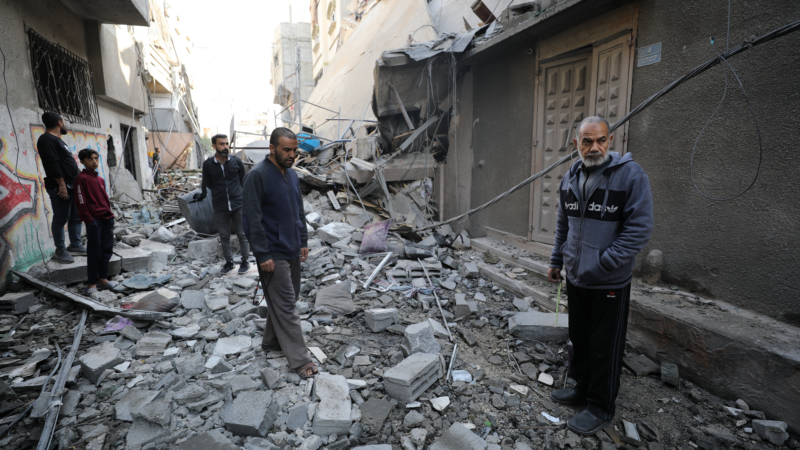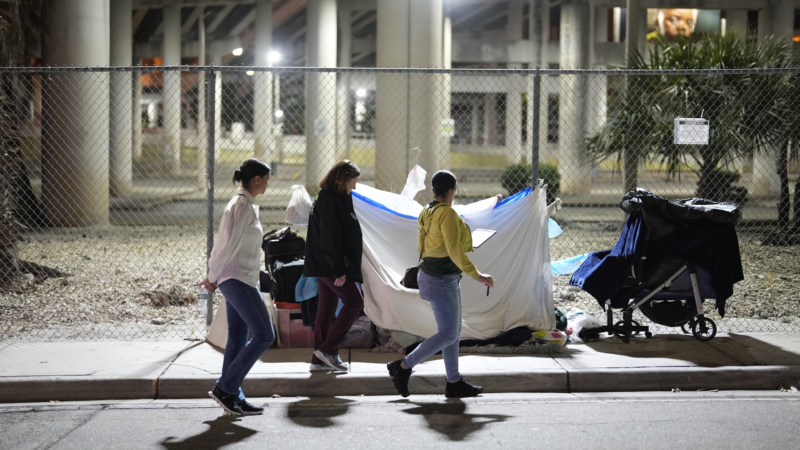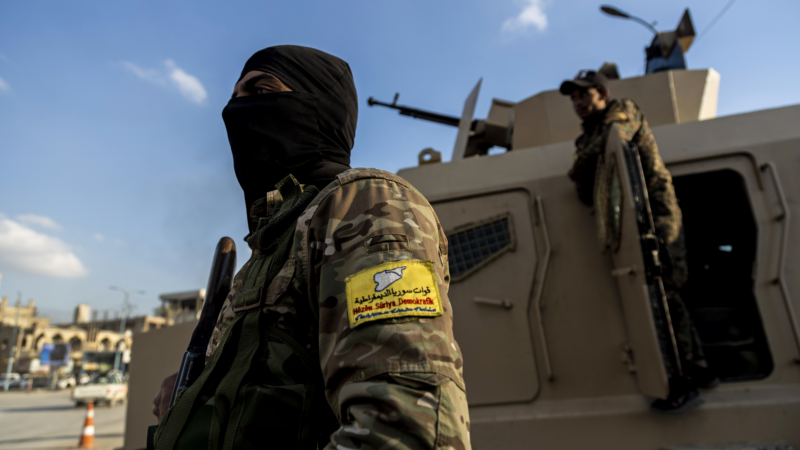Eyewitnesses in Gaza say Israel is using sniper drones to shoot Palestinians
TEL AVIV, Israel — “The shelling isn’t far from us at all,” says Fatma Daama. “The shelling is on our street, around us.”
In a series of voice messages recorded for NPR in her apartment on Oct. 9, the 37-year-old Palestinian in Jabalia describes Israeli tanks closing in, as her city and other parts of north Gaza were besieged by Israeli forces.
In one message, she’s interrupted by the sound of four quick gunshots.
“Oh, hear that?” she says casually. “That’s the quadcopter. It’s here most of the time. If I go to the door to get better cell service, the quadcopter starts shooting at me and I have to go back inside. It’s very dangerous.”
The quadcopter is what many Palestinians in the Gaza Strip call a small sniper drone with a gun attached that can fire single bullets. Over the past five months, NPR has collected accounts about sniper drones from more than a dozen eyewitnesses in Gaza, including Daama. Many say they’ve seen the drones shoot — and kill — civilians.
Adeeb Shaqfa, 55, lost his 32-year-old son Saher in such an attack. He says he and his son were walking in Rafah, in southern Gaza, on May 31. It was a quiet afternoon and there was no fighting nearby, he says, when a sniper drone appeared in the sky and shot Saher, who was walking up ahead.
“Two men rushed to help him, but the quadcopter also shot them,” Shaqfa says. “The quadcopter kept shooting everyone who tried to help.”
He says two older women nearby were shot in the head. Shaqfa tried to help them, but they were already dead. One of the men who tried to help his son was killed too, he says.
Eyewitness accounts point to use of sniper drones in different parts of Gaza
The Israeli military tells NPR it is unaware of this incident, which it says “do[es] not align in any way with IDF directives and protocols,” using the initials for the Israel Defense Forces. It says any suggestion that it “intends to harm civilians is unfounded and baseless.”
Earlier this month, British surgeon Dr. Nizam Mamode testified before the U.K. Parliament’s International Development Committee about his experience volunteering in August and September at Nasser Hospital in central Gaza, where he said he treated many injuries from sniper drones.
“The drones would come down and pick off civilians, children. And we had description after description. This is not, you know, an occasional thing,” Mamode testified. “This was day after day after day, operating on children, who would say, ‘I was lying on the ground after a bomb had dropped, and this quadcopter came down and hovered over me and shot me.’ “
Many of those who spoke with NPR brought up these attacks in an offhand way — a reflection, perhaps, of how common the technology seems to them in the war. But little has been reported on it. Israel has not confirmed using sniper drone technology. Israel’s United Nations Ambassador Danny Danon told NPR’s All Things Considered he could not respond to specific questions about sniper drone use, saying, “We are using sophisticated weapons in order to minimize civilian casualties. The fact that we have sophisticated weapons, it helps us to target and kill the terrorists. And that’s what we are trying to do.”
NPR has gathered the following additional accounts from eyewitnesses in Gaza:
- In Beit Lahiya, in the north, several Palestinians tell NPR that sniper drones shot at civilians late last month as they rushed to help pull people from the rubble after an Israeli airstrike leveled a building full of families. “We came back the day after the strike to try to recover the bodies of our family, but the Israeli quadcopter started shooting at us. We weren’t able to get to them,” Mohammed Ashraf Abu El Nasr, 18, says.
- Dr. Ghassan Abu Sitta, a visiting surgeon from the U.K., describes sniper drones firing on people as they tried to enter Al Ahli hospital in Gaza City, where he was working last November. He tells NPR he saw more than 20 injuries in one day from sniper drone shots, including at least one child shot in the neck. That child later died.
- Khaled Abdel Moneim, 27, tells NPR in July he witnessed a sniper drone opening fire in a camp full of displaced people in Nuseirat, in central Gaza. “It fired at people randomly,” he says. “It fired very, very, very heavily.”
- Dr. Mimi Syed, an American emergency and trauma physician who worked at Nasser Hospital in central Gaza for a month this past summer, says she had multiple patients a day — many in pediatrics — with single gunshot wounds to the head. “Every time someone would come in, they would be brought by family, and it was my routine practice to ask what happened. And every time, it would be a quadcopter drone shot,” Dr. Syed says. “And this was on individual days, from different parts of Gaza, in individual incidents, over and over again.”
- In July, Youssef Abd-Alatif, 30, told NPR about his experience with a sniper drone in central Gaza. “We were sitting at home, and then suddenly a sound came, like the sound of fans, and it started getting closer,” Abd-Alatif said, describing hearing the drone. “Then it started firing randomly everywhere, and the sound kept getting closer and closer, and the shooting increased everywhere.” He and his family fled and found shelter in a school. But many others in his neighborhood, he says, were injured or killed in that incident.
NPR shared details of these accounts with Israel’s military, which responded: “The claim that the IDF carries out indiscriminate fire towards children or other uninvolved civilians is completely baseless. The IDF is committed to the international law, as well as the law of armed conflict, and operates accordingly.”
There is evidence that Israel’s military has sniper drone technology
The Israeli military has not responded to NPR’s repeated question if it could verify its use of sniper drone technology in Gaza.
“Israel, frankly, like many militaries, is very cautious about what kinds of information it provides about its operations and tactics that it uses,” says Seth Jones, director of defense and security at the Center for Strategic and International Studies in Washington, D.C. “But that also makes it more difficult for everyday Israelis or journalists or other researchers to understand how these things are being used.”
Further hampering that understanding was a decades-long Israeli censorship law — lifted in 2022 — forbidding the media from reporting on its use of armed drones. And Israel has not allowed outside journalists independent access to report on the war inside Gaza, where health officials say more than 44,000 people have been killed since the war began after the Hamas-led attack of Oct. 7, 2023, which Israel says killed some 1,200 people.
But sniper drone technology — distinct from that of other armed drones, which often carry bombs — does exist, and videos released by some drone makers and the Israeli defense ministry indicate that the Israeli military has acquired it.
In 2014, veterans of Israeli special forces units formed a U.S.-based company called Duke Robotics, which later announced it had created the TIKAD — a small drone with a camera that could be outfitted with several different types of lightweight firearms and shoot while it hovers, adjusting for the recoil of the weapons. A 2018 marketing video describes the drones as “the future soldier” that can be “deployed to places human soldiers can’t reach, or simply shouldn’t have to go.” The video says the company “is in the process of implementing orders from Israeli forces.”
At the end is a tagline: “No boots on the ground.”
Around the same time, the Israeli defense ministry shared a video with Israeli press showing some of its newest technology, starting with soldiers seen operating one of Duke Robotics’ sniper drones and firing at targets at an outdoor shooting range.
In 2021, Duke Robotics announced it had joined with an Israeli company, Elbit Systems, specifically to further develop the TIKAD drone and market it globally.
Other similar drones are on the market, also made by Israeli companies.
In 2022, an Israeli company called Smartshooter announced a drone called Smash Dragon. A YouTube video posted by the company shows a small drone attached with a rifle barrel taking flight. The video then zooms in through the drone viewfinder to show the drone locking in on a human-shaped target before taking a shot. Smartshooter’s website says it uses artificial intelligence and machine learning technology to provide what it calls “‘one shot-one hit’ precision.”
In response to a question from NPR, Smartshooter denied that its Smash Dragon drone is being used by the Israeli military. But Israeli forces have touted the use of other Smartshooter technology in the past, and some other Smartshooter products are partially funded by Israel’s Defense Ministry’s research and development wing.
A Gaza hospital treats sniper drone attack victims — including its own personnel
Dr. Ahmad Moghrabi, a head surgeon at Nasser Hospital in central Gaza, says he and his colleagues are very familiar with the sniper drone, which they refer to as the quadcopter.
“The gunshot of the quadcopter, it has a special sound,” he explains. “They used to shoot at the displaced people inside the hospital, and they killed many people actually at the hospital,” he says.
In early February, Nasser Hospital was a focus of the Israeli military, which said Hamas fighters were hiding there. (The hospital has not commented publicly on this allegation). Hundreds of Palestinian civilians, displaced by fighting, had taken shelter there.
Moghrabi says he has treated many people shot by sniper drones — and saved the life of his own co-worker, a nurse who was shot in the chest by a drone on Feb. 1 while the two men were taking a break together on a first-floor balcony after a long surgery.
In a video from the day, which Moghrabi recorded on his phone and sent to NPR, blood blooms from a bullet wound on the nurse’s right chest as two colleagues hurriedly help him through the hospital hallways, and then lift him onto an operating table. Colleagues cut away his jacket and scrubs and start an IV drip, getting ready to operate.
The Israeli military tells NPR it is unaware of this incident.
Weaponized drones are part of warfare’s present and future
“We’re reaching a point where there is increasingly diminished human oversight over the practice of killing in war, and also the decision-making process around who lives or dies,” says James Rogers, an expert on drone warfare and emerging technologies at Cornell University.
“No matter how precise your weapon systems are,” he says, “if your intelligence is wrong, then all that precision, that guaranteed destruction of the target, means is the guaranteed death of the wrong person.”
And, as Jones from CSIS points out, once technology exists, it rarely goes away.
“The reality is, this is an evolution in the character of war,” Jones says. “So I don’t think we’re going to turn around and go the other direction.”
Weaponized drones, he says, are part of the future of warfare.
Ahmed Abuhamda contributed to this report from Cairo. Abu Bakr Bashir contributed from London. Itay Stern contributed from Tel Aviv and Yanal Jabarin contributed from Jerusalem.
Transcript:
JUANA SUMMERS, HOST:
Last week British surgeon Nizam Mamode testified in front of a committee in the U.K. Parliament.
(SOUNDBITE OF ARCHIVED RECORDING)
NIZAM MAMODE: What I think I found particularly disturbing…
SUMMERS: Dr. Mamode had recently returned from working at a hospital in Central Gaza, and he told parliamentary members what he witnessed, including…
(SOUNDBITE OF ARCHIVED RECORDING)
MAMODE: A bomb would drop, maybe on a crowded, tented area. And then the drones would come down, and…
SUMMERS: A new kind of drone in the Israeli arsenal, one with a gun and a camera attached that can shoot remotely.
(SOUNDBITE OF ARCHIVED RECORDING)
MAMODE: So the drones would come down and pick off civilians, children. And we had description after description. This is not, you know, an occasional thing. This was day after day after day.
SUMMERS: For months, NPR has been collecting eyewitness accounts from Gaza that corroborate Dr. Mamode’s testimony, saying the Israeli military has been using sniper drone technology and that they’re shooting civilians, NPR’s Kat Lonsdorf reports. And a warning – this piece includes the sound of gunfire.
KAT LONSDORF, BYLINE: Thirty-seven-year-old Fatma Daama is a freelance journalist from Jabalia in Northern Gaza. It’s an area that has been besieged by Israeli forces since early October. Daama sent NPR voice notes from her home there on October 9.
FATMA DAAMA: (Non-English language spoken).
LONSDORF: “Hi. How are you,” she starts.
DAAMA: (Non-English language spoken).
LONSDORF: “Israeli tanks are closing in,” she says, “and the army is nearby.” Suddenly, she’s interrupted.
(SOUNDBITE OF GUNS FIRING)
DAAMA: (Speaking Arabic).
LONSDORF: “Hear that,” she says. “That’s the quadcopter.” It’s what many in Gaza call the small, hovering drone with a rifle mounted underneath.
DAAMA: (Speaking Arabic).
LONSDORF: “If I try to go closer to the door to get better service,” she says, “the quadcopter starts shooting, and I have to go back inside. It’s very dangerous.”
DAAMA: (Speaking Arabic).
LONSDORF: “The town is under siege by the shooting quadcopter drones,” she says. “No one can move.” For months, NPR has collected accounts for more than a dozen people in Gaza who say they’ve seen these sniper drones and that they’ve seen them used to shoot and sometimes kill civilians.
ADIP SHAQFA: (Speaking Arabic).
LONSDORF: Fifty-five-year-old Adib Shaqfa says he was walking with his 32-year-old son on May 31 in Rafah in Southern Gaza.
SHAQFA: (Speaking Arabic).
LONSDORF: Shaqfa says it was a quiet day. There was no fighting nearby when suddenly…
SHAQFA: (Speaking Arabic).
LONSDORF: …A drone appeared and shot his son, who was walking up ahead. He says two men rushed in to help his son, and they were also shot.
SHAQFA: (Speaking Arabic).
LONSDORF: Two older women nearby were also shot in the head, he says. Shaqfa says the women were killed. So was his son. The Israeli military told NPR it’s unaware of this incident and that any suggestion that it intends to harm civilians is unfounded and baseless. NPR also asked the Israeli military repeatedly if it was using the sniper drone technology in Gaza. It did not respond to the question.
SETH JONES: Israel, frankly, like many militaries, is very cautious about what kinds of information it provides about its operations and tactics that it uses.
LONSDORF: Seth Jones is president of the Defense and Security Department at the Center for Strategic and International Studies in Washington, D.C.
JONES: But it also makes it more difficult for everyday Israelis or journalists or other researchers to understand how these things are being used.
LONSDORF: Further complicating that understanding, until recently, Israel had a censorship law in place forbidding the media from reporting on armed drone use by the military. And it’s something most journalists can’t witness with their own eyes. Israel has not allowed outside journalists independent access to Gaza since the war began more than a year ago. But we do know that this sniper drone technology exists and that the Israeli military has it. This is a video from 2018 by Duke Robotics Incorporated…
(SOUNDBITE OF YOUTUBE VIDEO, “DUKE ROBOTICS – TIKAD DRONE – THE FUTURE SOLDIER”)
UNIDENTIFIED PERSON #1: Duke Robotics presents…
LONSDORF: …For a small drone they call…
(SOUNDBITE OF YOUTUBE VIDEO, “DUKE ROBOTICS – TIKAD DRONE – THE FUTURE SOLDIER”)
UNIDENTIFIED PERSON #1: …TIKAD…
LONSDORF: …TIKAD…
(SOUNDBITE OF YOUTUBE VIDEO, “DUKE ROBOTICS – TIKAD DRONE – THE FUTURE SOLDIER”)
UNIDENTIFIED PERSON #1: …The future soldier.
LONSDORF: …Which can be outfitted with several different firearms…
(SOUNDBITE OF YOUTUBE VIDEO, “DUKE ROBOTICS – TIKAD DRONE – THE FUTURE SOLDIER”)
UNIDENTIFIED PERSON #1: Robots are replacing combat soldiers.
LONSDORF: …And shoot while it hovers, adjusting for the recoil of the weapon.
(SOUNDBITE OF YOUTUBE VIDEO, “DUKE ROBOTICS – TIKAD DRONE – THE FUTURE SOLDIER”)
UNIDENTIFIED PERSON #1: The company is in the process of implementing orders from Israeli forces.
LONSDORF: Duke Robotics is based in Florida in the U.S. but was established by veterans of several Israeli special forces units. Around that same time, Israel’s defense ministry released a video showing off new technology, including soldiers controlling one of Duke’s sniper drones remotely and firing at targets at an outdoor shooting range. Then in 2021, Duke Robotics joined with an Israeli company, Elbit Systems, specifically to further develop the TIKAD drone and market it globally. And there are other sniper drones in the market, too, also by Israeli companies.
In 2022, a company called SMARTSHOOTER based in Northern Israel announced a drone called SMASH Dragon. In this YouTube video posted by the company, a small drone with a rifle barrel attached takes flight. The video then zooms in through the viewfinder to show the drone locking in on a human-shaped target before taking a shot. SMARTSHOOTER denies that their SMASH Dragon drone is being used by the Israeli military, but Israeli forces have touted using their technology in the past, and other products by the company are partially funded by Israel’s defense ministry research and development. On SMARTSHOOTER’s website, it says it uses artificial intelligence and machine learning technology to provide, quote, “one-shot, one-hit precision.”
JAMES ROGERS: I would argue we’re reaching a point where there are increasingly diminished human oversight over the practice of killing in war and also the decision-making process around who lives or dies.
LONSDORF: James Rogers is an expert on drone warfare and emerging technologies at Cornell University. He points out that precision can be good. But…
ROGERS: No matter how precise your weapon systems are, if your intelligence is wrong, then all that precision, that guaranteed destruction of the target means is the guaranteed death of the wrong person.
AHMED MOGHRABI: The gunshot of the quadcopter has a special sound.
LONSDORF: Dr. Ahmed Moghrabi is a head surgeon at Nasser Hospital in Central Gaza. He says he’s treated many people shot by the sniper quadcopter drone.
MOGHRABI: They used to shoot at the displaced people inside the hospital, and they killed many people, actually.
LONSDORF: Back in early February, Nasser Hospital was a focus of the Israeli military, saying Hamas fighters were hiding there. On February 1, Dr. Moghrabi says he and his coworker, a male nurse, stepped out onto a balcony after finishing a long surgery.
MOGHRABI: The quadcopter actually shoot at my nurse friend beside me.
LONSDORF: A drone shot the nurse in the chest.
(SOUNDBITE OF ARCHIVED RECORDING)
MOGHRABI: They shooted (ph) at us. (Non-English language spoken).
LONSDORF: Dr. Moghrabi sent us a video he filmed that day. Colleagues rushed the nurse into an operating room as blood blooms around a bullet wound on his right chest.
(SOUNDBITE OF ARCHIVED RECORDING)
MOGHRABI: (Non-English language spoken).
UNIDENTIFIED PERSON #2: (Non-English language spoken).
MOGHRABI: (Non-English language spoken).
LONSDORF: “Quickly, quickly,” Dr. Moghrabi says as others cut away the nurse’s clothing to operate. The nurse survived. The Israeli military told NPR it was unaware of this incident as well.
Here are just a few of the other stories we heard. Several people we talked to in Beit Lahia in the north described sniper drones recently shooting at civilians as they rushed to help pull people from the rubble after an Israeli airstrike leveled a building full of families. One man said a sniper drone entered his house with his family inside, started shooting, forcing them to flee. One doctor from the U.K. described sniper drones firing on people as they tried to enter a hospital in Gaza city, where he was working. He told NPR he saw more than 20 injuries in one day from the drones, including one child shot in the neck, who later died.
Although there’s been very little reporting on these drones, people in Gaza talk about them a lot. Most people we talked to brought up these attacks offhandedly. Sniper drones seem to have become so common in the war. And as Seth Jones points out, once technology exists, it rarely goes away.
JONES: The reality is this is an evolution in the character of war. So I don’t think we’re going to turn around and go the other direction.
LONSDORF: This might very well be the future of warfare. Kat Lonsdorf, NPR News, Tel Aviv.
Trump asks the Supreme Court to delay the start of the TikTok ban
President-elect Donald Trump asked the Supreme Court on Friday to pause the potential TikTok ban from going into effect until his administration can pursue a "political resolution" to the issue.
U.S. homelessness jumps to another record high, amid affordable housing shortage
The annual federal count finds more than 770,000 people living in shelters or outside. It cites rising rents and the recent surge in migrants as key factors behind the increase.
Sportscaster Greg Gumbel dies at age 78
Greg Gumbel, a longtime CBS sportscaster, has died from cancer, according to a statement from family released by CBS on Friday. He was 78.
Costco egg recall for salmonella receives FDA’s most severe designation
The FDA has classified its recall of eggs sold under Costco's Kirkland brand as a Class I recall, a designation reserved for instances of the highest potential health risk — including death.
Syria’s U.S.-backed Kurdish coalition faces an uncertain future after Assad’s ouster
After Bashar al-Assad's ouster, there are questions about the fate of the Syrian Democratic Forces, the U.S.-backed Kurdish coalition that currently controls a third of Syrian territory.
Claim of dementia could derail former Abercrombie CEO’s sex trafficking case
Can his legal team's claims that he has late-onset Alzheimer's disease and dementia put a pause in the sex trafficking trial of former Abercrombie & Fitch CEO Mike Jeffries?






